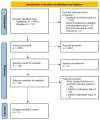Utility of Metagenomic Next-Generation Sequencing in Infective Endocarditis: A Systematic Review
- PMID: 36551455
- PMCID: PMC9774888
- DOI: 10.3390/antibiotics11121798
Utility of Metagenomic Next-Generation Sequencing in Infective Endocarditis: A Systematic Review
Abstract
Blood cultures have been the gold standard for identifying pathogens in infective endocarditis (IE). Blood culture-negative endocarditis (BCNE), however, occurs in 40% or more of IE cases with the bulk of them due to recent antibiotic exposure prior to obtaining blood cultures. Increasingly, molecular techniques are being used for pathogen identification in cases of BCNE and more recently has included metagenomic next-generation sequencing (mNGS). We therefore performed a literature search on August 31, 2022, that assessed the mNGS in IE and 13 publications were identified and included in a systematic review. Eight (61.5%) of them focused only on IE with mNGS performed on cardiac valve tissue in four studies, plasma in three studies and cardiac implantable electronic devices (CIED) in one study. Gram-positive cocci, including Staphylococcus aureus (n = 31, 8.9%), coagulase-negative staphylococci (n = 61, 17.6%), streptococci (n = 130, 37.5%), and Enterococcus faecalis (n = 23, 6.6%) were the predominant organisms identified by mNGS. Subsequent investigations are needed to further define the utility of mNGS in BCNE and its impact on patient outcomes. Despite some pitfalls, mNGS seems to be of value in pathogen identification in IE cases, particularly in those with BCNE. This study was registered and on the Open Science Framework platform.
Keywords: cardiovascular implantable electronic devices; device-related infections; diagnosis; infective endocarditis; metagenomic next-generation sequencing; molecular.
Conflict of interest statement
The authors declare no conflict of interest.
Figures


Similar articles
-
Infective endocarditis caused by Streptococcus sinensis diagnosed with next-generation sequencing: a case report and literature review.BMC Infect Dis. 2025 Mar 27;25(1):425. doi: 10.1186/s12879-025-10837-2. BMC Infect Dis. 2025. PMID: 40148753 Free PMC article. Review.
-
The clinical value of valve metagenomic next-generation sequencing when applied to the etiological diagnosis of infective endocarditis.Ann Transl Med. 2021 Oct;9(19):1490. doi: 10.21037/atm-21-2488. Ann Transl Med. 2021. PMID: 34805352 Free PMC article.
-
Application of Metagenomic Next-Generation Sequencing in the Etiological Diagnosis of Infective Endocarditis During the Perioperative Period of Cardiac Surgery: A Prospective Cohort Study.Front Cardiovasc Med. 2022 Mar 8;9:811492. doi: 10.3389/fcvm.2022.811492. eCollection 2022. Front Cardiovasc Med. 2022. PMID: 35369282 Free PMC article.
-
The emergence of Staphylococcus aureus as the primary cause of cardiac device-related infective endocarditis.Infection. 2021 Oct;49(5):999-1006. doi: 10.1007/s15010-021-01634-5. Epub 2021 Jun 5. Infection. 2021. PMID: 34089482
-
Laboratory Approach to the Diagnosis of Culture-Negative Infective Endocarditis.Heart Lung Circ. 2017 Aug;26(8):763-771. doi: 10.1016/j.hlc.2017.02.009. Epub 2017 Mar 16. Heart Lung Circ. 2017. PMID: 28372886 Review.
Cited by
-
Finding of Anaerococcus hydrogenalis in blood using cell-free DNA technique in a patient with infective endocarditis.Germs. 2023 Sep 30;13(3):282-287. doi: 10.18683/germs.2023.1396. eCollection 2023 Sep. Germs. 2023. PMID: 38146378 Free PMC article.
-
Real-world clinical impact of plasma cell-free DNA metagenomic next-generation sequencing assay.Infect Control Hosp Epidemiol. 2025 Jan 30;46(5):1-8. doi: 10.1017/ice.2024.242. Online ahead of print. Infect Control Hosp Epidemiol. 2025. PMID: 39881594 Free PMC article.
-
The Diagnostic Accuracy of Metagenomic Next-Generation Sequencing in Diagnosing Pneumocystis Pneumonia: A Systemic Review and Meta-analysis.Open Forum Infect Dis. 2023 Aug 18;10(9):ofad442. doi: 10.1093/ofid/ofad442. eCollection 2023 Sep. Open Forum Infect Dis. 2023. PMID: 37674635 Free PMC article.
-
Understanding Bartonella-Associated Infective Endocarditis: Examining Heart Valve and Vegetation Appearance and the Role of Neutrophilic Leukocytes.Cells. 2023 Dec 25;13(1):43. doi: 10.3390/cells13010043. Cells. 2023. PMID: 38201247 Free PMC article.
-
Evaluation of 16S-Based Metagenomic NGS as Diagnostic Tool in Different Types of Culture-Negative Infections.Pathogens. 2024 Aug 30;13(9):743. doi: 10.3390/pathogens13090743. Pathogens. 2024. PMID: 39338934 Free PMC article.
References
-
- Miller J.M., Binnicker M.J., Campbell S., Carroll K.C., Chapin K.C., Gilligan P.H., Gonzalez M.D., Jerris R.C., Kehl S.C., Patel R., et al. A Guide to Utilization of the Microbiology Laboratory for Diagnosis of Infectious Diseases: 2018 Update by the Infectious Diseases Society of America and the American Society for Microbiology. Clin. Infect. Dis. 2018;67:813–816. doi: 10.1093/cid/ciy584. - DOI - PubMed
-
- Baddour L.M., Wilson W.R., Bayer A.S., Fowler V.G., Jr., Tleyjeh I.M., Rybak M.J., Barsic B., Lockhart P.B., Gewitz M.H., Levison M.E., et al. Infective Endocarditis in Adults: Diagnosis, Antimicrobial Therapy, and Management of Complications: A Scientific Statement for Healthcare Professionals From the American Heart Association. Circulation. 2015;132:1435–1486. doi: 10.1161/CIR.0000000000000296. - DOI - PubMed
-
- Lamas C.C., Fournier P.E., Zappa M., Brandão T.J., Januário-da-Silva C.A., Correia M.G., Barbosa G.I., Golebiovski W.F., Weksler C., Lepidi H., et al. Diagnosis of blood culture-negative endocarditis and clinical comparison between blood culture-negative and blood culture-positive cases. Infection. 2016;44:459–466. doi: 10.1007/s15010-015-0863-x. - DOI - PubMed
Publication types
LinkOut - more resources
Full Text Sources

